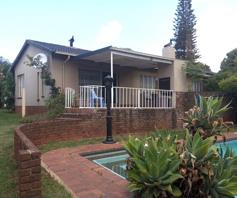Last year the property market in the seaside village of Kommetjie took a significant knock in terms of sales volumes, with registrations dropping from an average of 70 the previous four years to just 47, but it also saw an increase in the median house price which grew by 10.3%, from R2.9 million in 2016 to R3.2 million in 2017.
 This home on a large stand in Imhoffs Gift, Kommetjie, offers views, three bedrooms, two bathrooms, a farmhouse kitchen and verandah. It is on the market for R3.15 million - click here to view.
This home on a large stand in Imhoffs Gift, Kommetjie, offers views, three bedrooms, two bathrooms, a farmhouse kitchen and verandah. It is on the market for R3.15 million - click here to view.Citing Lightstone data, Lew Geffen, Chairman of Lew Geffen Sotheby’s International Realty, adds that vacant land did not fare as well, with the median sale price dipping by 26.9% to R1.188 million after a high of R1.625 million in 2016.
“And, like many other areas, the top end of the market was the worst hit. Propstats data reveals that in 2016, there were ten transactions for more than R5 million, with two being in the R10 million-plus price band, but last year there were only four sales above R5 million, and none in the higher bracket.”
“Houses priced below R3.5 million have continued to sell reasonably well if realistically priced, but buyers have become a lot more cautious and circumspect due to a number of factors, including political uncertainty, the drought and limited realistically priced stock,” says Natalie Cooper, Area Specialist for the group.
 This double-storey townhouse in Kommetjie has three bedrooms, two bathrooms, a single automated garage and mountain views. It is in a complex with pool, and is on the market for R1.895 million - click here to view.
This double-storey townhouse in Kommetjie has three bedrooms, two bathrooms, a single automated garage and mountain views. It is in a complex with pool, and is on the market for R1.895 million - click here to view.“Changing buyer needs have also affected the market, with a growing demand for water-wise homes with features like boreholes, wells and greywater systems, and we are also fielding more and more requests for dual living properties. Homes with sea views and good security remain in high demand.”
For decades, Kommetjie was traditionally home to the local ‘arty’ set and surfing community, inhabited by long-term residents who seldom moved away, but this has changed in recent years.
“In 2013 the market in Kommetjie began to pick up really well, with the number of registrations jumping from 58 to 71, and the median house price nudging the R2 million mark for the first time,” says Geffen.
“This was largely fuelled by two emergent trends - semigration from Gauteng and the growing number of people seeking a more tranquil lifestyle which continued to drive the steady growth we saw until the end of 2016.”
 This three bedroom, two-and-a-half bathroom home in Kommetjie has a double-volume lounge with fireplace, double garage, greenhouse and fruit trees. It is selling for R3.2 million - click here to view.
This three bedroom, two-and-a-half bathroom home in Kommetjie has a double-volume lounge with fireplace, double garage, greenhouse and fruit trees. It is selling for R3.2 million - click here to view.Although semigration has notably slowed during the last year, Cooper says she believes that the lifestyle Kommetjie offers, as well as its affordability compared to many other seaside suburbs in Cape Town, will continue to attract buyers, especially those seeking a laidback life away from the growing urbanisation.
“Kommetjie is a haven for water sports and outdoors enthusiasts, and residents here can indulge in all manner of activities including surfing, hiking, crayfishing, horse riding, boating and cycling without venturing very far from their front doors,” says Cooper.
“And while they may feel a million miles from the city, Kommetjie is self-sufficient with just about all amenities available in the village as well as in the surrounding area, including malls, medical care and several excellent schools, and nearby business centres like Westlake Business Park are only a short drive away.”
 This property offers a four bedroom, three bathroom home and one bedroom flatlet, pool, garaging for four cars. It is selling for R4.32 million - click here to view.
This property offers a four bedroom, three bathroom home and one bedroom flatlet, pool, garaging for four cars. It is selling for R4.32 million - click here to view.She adds that very few areas in Cape Town still cater to investors across the market spectrum, from young families through to couples looking to downscale, and buyers have begun to appreciate what their money can buy on the West Peninsula.
“Although 2018 is showing promising signs of improvement thus far, investors are still cautious, so the market may take a while to re-adjust, but with realistically priced stock I remain confident that we will have a good year,” says Cooper.







